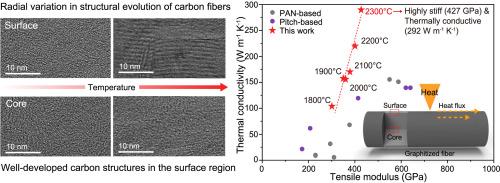Unveiling the graphitization behaviors of highly stiff and thermally conductive graphitic carbon fibers
IF 11.6
2区 材料科学
Q1 CHEMISTRY, PHYSICAL
引用次数: 0
Abstract
We explored the potential of highly stiff and thermally conductive carbon fibers for thermal management applications. The polyacrylonitrile (PAN)-based carbon fibers were graphitized up to 2300 °C through a continuous process, resulting in a tensile modulus of 427 GPa. Microstructural analysis revealed a trade-off reaction between mechanical properties during the graphitization process. This trade-off reaction in mechanical properties occurred because of the rearrangement of the crystalline structure above 2000 °C. The intrinsic properties of graphite, particularly its high in-plane energy conduction during the graphitization, led to the rearrangement and coalescence of crystalline structures in the near-surface region. Consequently, excessive grain boundaries were evident in the surface regions, causing a trade-off reaction. It was evident that the fibers graphitized at 2300 °C exhibited highly developed carbon structures in surface regions with a mixed stacking order. The measured thermal conductivity reached up to 292 W m−1 K−1, considerably higher than commercial PAN-based carbon fibers, overcoming the limitations of polymeric carbon materials. This enhanced conductivity originated from the highly developed carbon structures in the surface regions, which acted as an effective pathway for energy conduction. The resulting fibers exhibited enormous potential as thermal management materials for lightweight applications.

揭示了高刚性导热石墨炭纤维的石墨化行为
我们探索了高硬度和导热碳纤维在热管理应用中的潜力。通过连续工艺将聚丙烯腈(PAN)基碳纤维石墨化至2300℃,拉伸模量为427 GPa。微观结构分析揭示了石墨化过程中力学性能之间的权衡反应。这种机械性能的权衡反应是由于在2000℃以上晶体结构的重排而发生的。石墨的固有性质,特别是石墨化过程中高的面内能量传导,导致了近表面区域晶体结构的重排和聚并。因此,过量的晶界在表面区域是明显的,造成权衡反应。结果表明,在2300℃下石墨化的纤维在表面区域表现出高度发达的碳结构和混合的堆叠顺序。测得的导热系数高达292 W m−1 K−1,大大高于商用pan基碳纤维,克服了聚合物碳材料的局限性。这种增强的电导率源于表面区域高度发达的碳结构,这是能量传导的有效途径。由此产生的纤维显示出巨大的潜力,作为轻质应用的热管理材料。
本文章由计算机程序翻译,如有差异,请以英文原文为准。
求助全文
约1分钟内获得全文
求助全文
来源期刊

Carbon
工程技术-材料科学:综合
CiteScore
20.80
自引率
7.30%
发文量
0
审稿时长
23 days
期刊介绍:
The journal Carbon is an international multidisciplinary forum for communicating scientific advances in the field of carbon materials. It reports new findings related to the formation, structure, properties, behaviors, and technological applications of carbons. Carbons are a broad class of ordered or disordered solid phases composed primarily of elemental carbon, including but not limited to carbon black, carbon fibers and filaments, carbon nanotubes, diamond and diamond-like carbon, fullerenes, glassy carbon, graphite, graphene, graphene-oxide, porous carbons, pyrolytic carbon, and other sp2 and non-sp2 hybridized carbon systems. Carbon is the companion title to the open access journal Carbon Trends. Relevant application areas for carbon materials include biology and medicine, catalysis, electronic, optoelectronic, spintronic, high-frequency, and photonic devices, energy storage and conversion systems, environmental applications and water treatment, smart materials and systems, and structural and thermal applications.
 求助内容:
求助内容: 应助结果提醒方式:
应助结果提醒方式:


